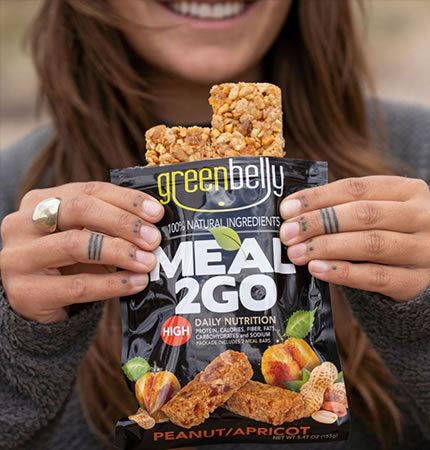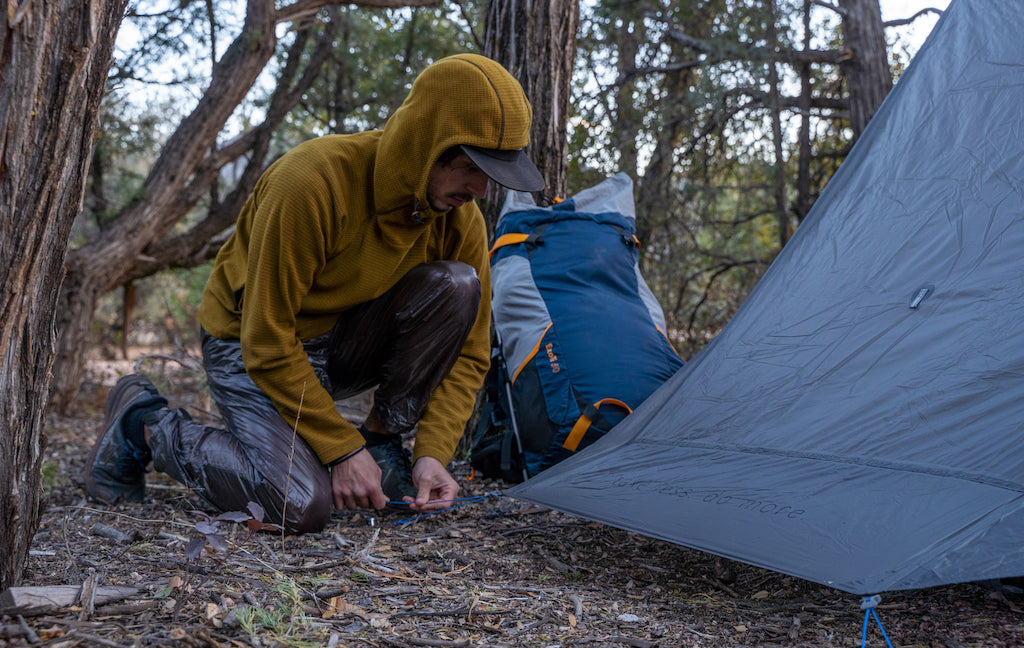The HMG Flat Tarp is about the lightest shelter a hiker can buy, making it ideal for the weight-conscious thru-hiker. While the basic design is simple, the many guy out points and included lines provide countless pitch options and flexibility for those willing to put time into good campsite selection.
Product Overview
✅ Extremely lightweight
✅ Versatile
✅ Simple design
✅ No zippers
❌ Fabric durability
❌ Takes practice to set up
❌ Difficult to use in bad weather
- Dimensions: 8'6" x 8'6" and 8' x 10'
- Packed dimensions: 6.5” x 5.5” x 3.5” (square tarp); 6.5” x 5.5” x 3.5” (rectangular tarp)
- Packed weight: 9 oz/0.6 lbs (square tarp); 10.9 oz/0.7 lbs (rectangular tarp)
- Material: DCF8
- Seams: Fully bonded, stitchless ridgeline seam
- Guy-outs/tie-outs: 16 perimeter tie-outs; 4 in the center, 1/3, and 2/3 of the interior body
- D-rings: Two (2) Sewn in D-rings under the ridge line
- Tensioners included?: Yes
- Guy lines included?: Yes, Twelve (12) Ultralight 2.8mm UHMWPE Core Guy Lines
- Includes: Medium Drawstring Stuff Sack (Ultralight Stake Kit sold separately; trekking poles not included)
To see reviews on other tarp shelters, check out our Best Ultralight Tarp Shelters and Configurations post.
Similar Products: Z Packs Flat Tarp, Rab Siltarp, MSR Thru-Hiker 70 Wing, Sea to summit Escapist Tarp
Performance Test Results
What We Tested:
How We Tested:
I used the HMG Flat Tarp while thru hiking an original Canada to Mexico route. The route took me through Idaho (on the Idaho Centennial Trail), Nevada, and Arizona. The conditions were primarily arid and warm to hot. There were approximately 10 nights with significant rain plus a smattering of light showers. I hiked and shared the tarp with my 70-pound German Shepherd Dog and 10-pound Border Terrier.
Weight
One of the biggest strengths of the Flat Tarp is it's extremely lightweight making it the choice of many hard-core ultralight backpackers. Lack of large amounts of fabric, and tent hardware such as zippers, or poles all contribute to the insanely small weight penalty. The other factor is the use of DCF (Dyneema Composite Fiber) which weighs less than silpoly making the tarp even lighter.
Compared to other Dyneema flat tarps, the HMG is slightly heavier than its competitors by an ounce or more depending on the design. This is mostly due to luxury features that HMG includes such as more tie-out points and tensioners, but the type of DCF used can also be a factor. It will be up to the buyer to decide how important those few ounces are on an already incredibly light shelter vs. the added versatility of the guy out points.
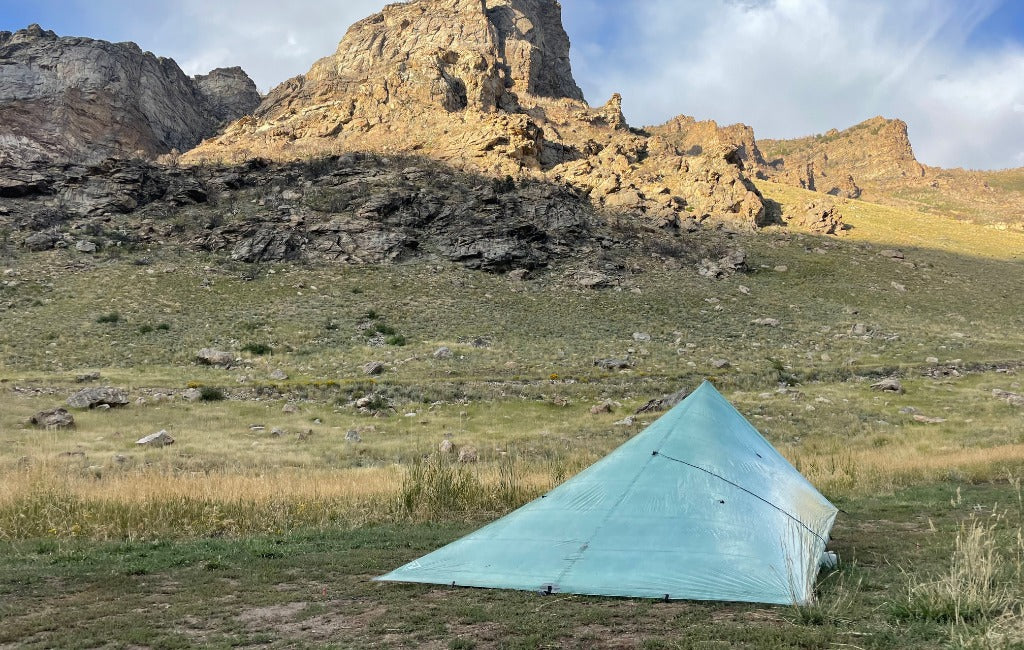
The HMG flat tarp is a bit heavier compared to other Dyneema flat tarps in the market.
Another thing to keep in mind when considering the weight of a tarp, or really any shelter, is that there will be added weight from required accessories. In this case, the weight of the guy lines, tent stakes, and ground sheet are not included. The added penalty from the stakes and guy lines can vary wildly depending on how the tarp is being pitched and how many stakeout points are needed.
Price
Dyneema has a reputation for being expensive and the HMG Flat Tarp is no exception. While the Flat Tarp is quite a bit cheaper than most other Dyneema shelters on the market at as much as half the price, it is about the equivalent of many high-end silpoly double-walled tents. Considering the simple design has less fabric and is more straightforward to manufacture, this just goes to show the premium less weight carries with it.
It is also worth mentioning that silpoly tarps tend to cost quite a bit less than the Flat Tarp. It can be a bit frustrating to pay such a premium for what is essentially a rectangle of fabric with some guy out points, but it isn’t just HMG. Most DCF flat tarps are around the same price, typically $50 or less below the cost of the HMG tarp depending on the color and brand. Overall, the Hyperlite Mountain Gear Flat Tarp is expensive for what you get, but in line with its competitors.
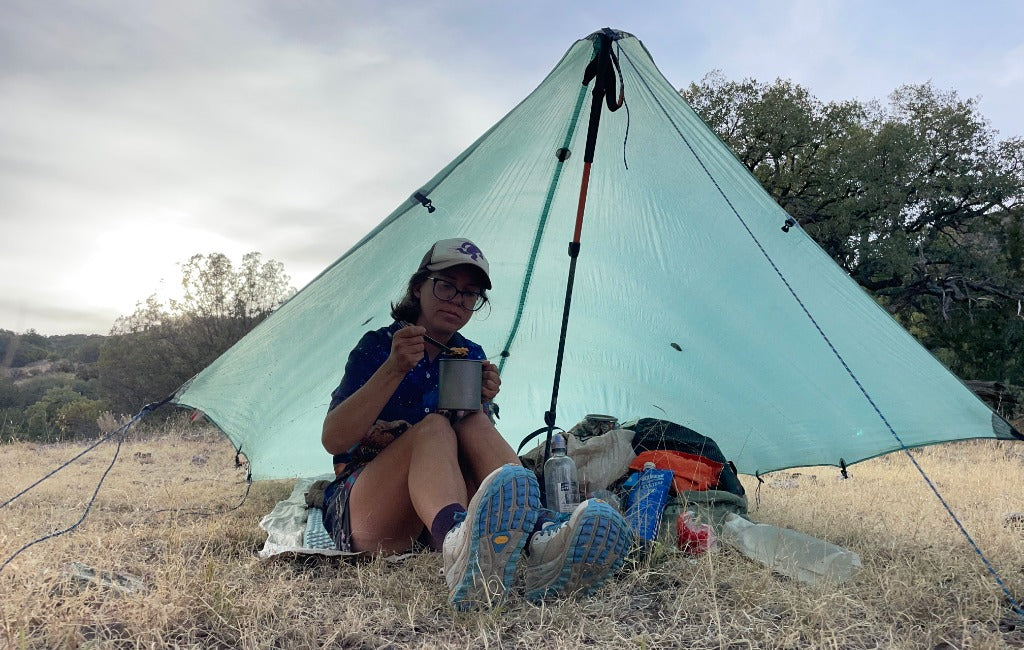
HMG Flat Tarp is comparable in price to its rivals retailing at $389.
Packability
The Flat Tarp has many characteristics that enable it to be an extremely packable shelter. The biggest factor is that there just isn’t a lot of fabric to pack down due to the simple design of the tarp. Less fabric means less space. In my experience, more complex shapes are also more challenging to fold up whereas packing up a Flat Tarp feels similar to folding a bed sheet. This makes it easier to squish it down into a very small square that fits easily in a variety of pack spaces.
Another pro of the simple, non-freestanding design is fewer accessories to pack. Users will need some sort of groundsheet, but these often stuff down small depending on what material is being used. The type of pitches being used will dictate the number of tent stakes, so it is easy to adjust the number carried per trip.
One of the biggest pros has to be that no dedicated tent poles are required for this shelter which saves a lot of vertical space. The biggest overall knock on this shelter when it comes to packability is the fabric material. Dyneema does not tend to pack down as small as a comparable amount of silpoly would.
However, in my experience, the Flat Tarp is one of the most compact shelter options on the market and packs significantly smaller than any other shelter I have used to date. It is a great option for those who are concerned about saving space in their pack.

The Flat Tarp is a compact, lightweight shelter that is ideal for those who prioritize space efficiency in their pack.
Design
Size
At first glance, the simple design of a flat tarp may not seem to have many features. It is just a rectangle of fabric after all. However, there are a few design features to keep in mind when considering a tarp shelter. The first major consideration is the size specification of the tarp. HMG offers an 8.6’ x 8.6’ and 8.6’ x 10’ option.
There will be different pitching options available depending on whether the tarp is a square or a rectangle. It is also for this reason that I have found the cut of a flat tarp to be a better choice in most situations than a tarp with a catenary cut. A catenary cut saves weight by eliminating excess fabric but is not nearly as flexible as a regular tarp.
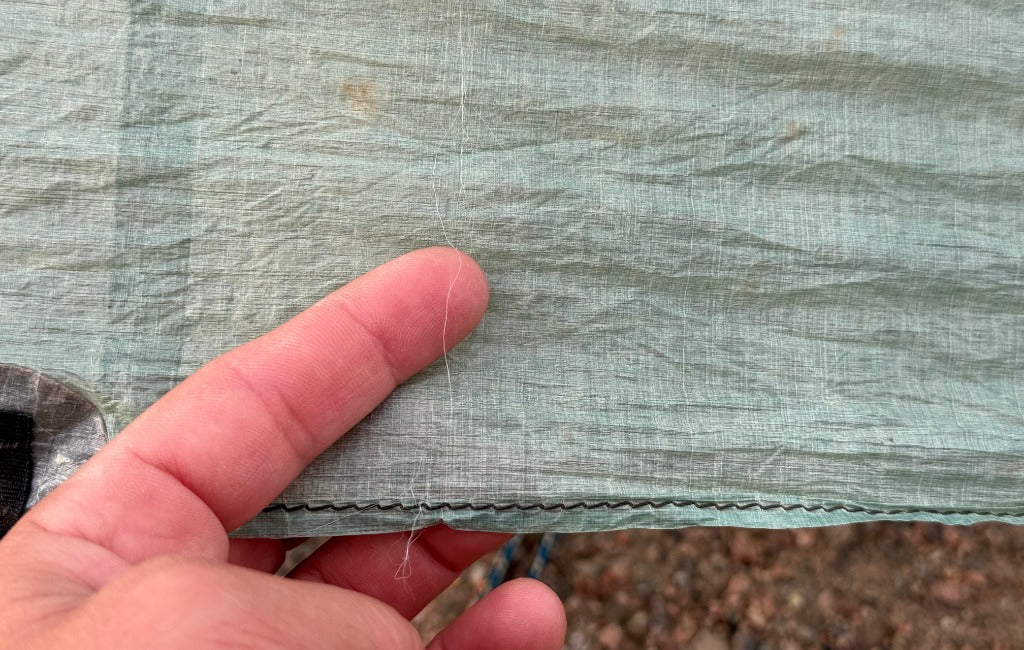
Guy-out
Other things to keep in mind are the number and location of guy out points and whether or not the tarp has a built-in tensioning system. HMG’s tarp has guy-out points at the corners along with three additional locations on each edge for a total of 16 guy-out points. This is extremely helpful for stabilizing the tarp during storms as well as for setting up more complicated pitches such as a protected half pyramid.
There are also two guy-out points in the middle of each long side and one in the exact middle of the tarp. This is significantly more guy-out locations than pretty much any other Dyneema flat tarp on the market. Each guy-out location is strengthened with extra Dyneema patches so there is a slight trade-off between the flexibility of more guy-out locations and weight.

Tensioners
When it comes to tensioners, there is a balance between weight, convenience, and flexibility. Hyperlite Mountain Gear has its own brand of tensioners, called line locks, on all of the edge guy out points. They are easy to use - pull one end of the cord to tighten and the other to loosen. This is great for those who want to minimize the number of knots they need to tie.
I found that they began to loosen slightly if the tarp was set up for a zero-day, but it was a quick fix. They also made moving the cords to different guy out points for new pitches slightly cumbersome compared to just threading the cord through a loop; however, the time penalty was a matter of seconds, so small overall. The good news is that those who would prefer to pitch the tarp without the use of the line locks can easily remove them with a pair of pliers.
D-rings
The final design feature that is worthy of note is the D-rings along the inside ridge of the tent. This feature is ideal for those who want to run a ridge line through the tarp but could also potentially be used for hanging a bug bivy or small lamp. Overall, flat tarps may have a simple design, but when it comes to HMG’s version it isn’t without its luxuries.
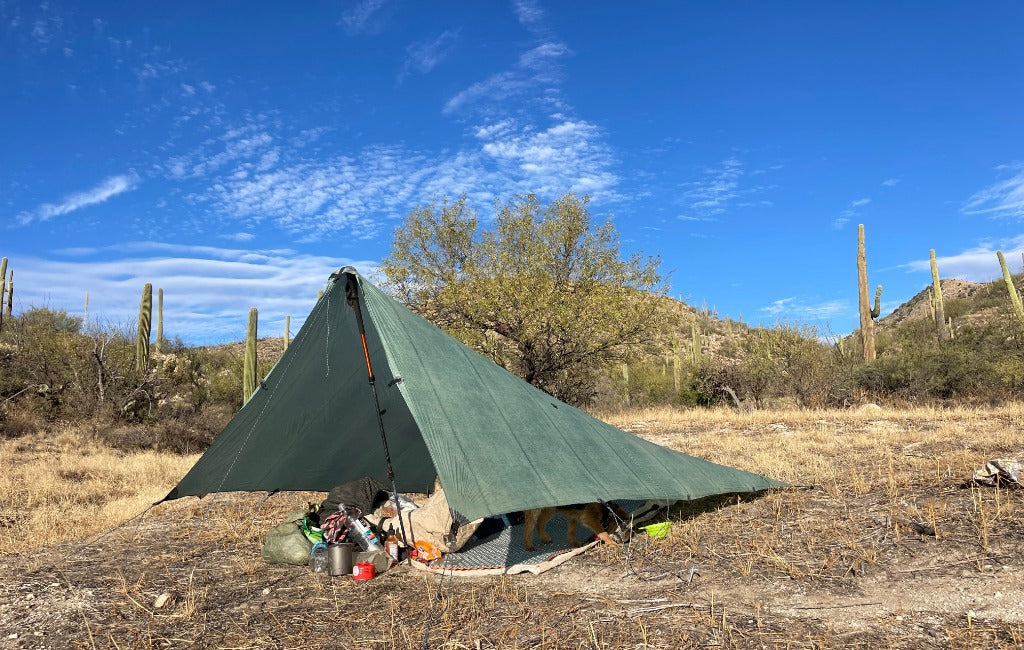
Ease of Use
Flat tarps like the one by HMG are notorious for being more finicky to set up. Unlike a regular freestanding tent, trekking pole shelters require at least some corners to be staked out before being erected. Figuring out what angles the different corners and sides need to be from each other in order to create a taught pitch takes practice and this is doubly true with a flat tarp.
Because flat tarps do not have a consistent or specific pitch, figuring out how to set up each new pitch can take time to figure out. Above and beyond just erecting the shelter, there is the issue of campsite selection and pitch selection based on weather and conditions. Choose a spot that is too low or flat and risk getting flooded in the rain. Set up a more open pitch such as a half pyramid and risk having grit blow into the tent if the wind shifts during a storm.
I have used several different tents before, including a different trekking pole shelter, and found the HMG Flat Tarp to be the most difficult to use during uncertain or poor weather. It required a lot more planning, gambling, and just general brain cells to use which can be frustrating after a long day of hiking.

On the flip side, it can provide a challenge for those who enjoy solving puzzles or who like to be in tune with their surroundings. Another aspect of using a tarp was the sheer volume of pitch formations that could be used. While this versatility is one of the things that drew me to purchase the Flat Tarp, it can also be overwhelming when first using this shelter.
I found it helpful to choose 2 to 3 pitches to learn in the backyard that would be suitable for a variety of scenarios, and then build from there over time. There are several features of the tarp that aid in ease of use. I feel that overall the built-in tensioners really did make it easier to pitch this tarp when I was first learning as well as when I was in a hurry.
It is still a good idea to brush up on knots as some of the more complex or creative pitches will require it. Along with that, the ability to swap out or customize the guy lines make a huge difference when pitching this tarp in rocky or cramped areas. Compared to other shelters I have used, the longer lines of the Flat Tarp made it easy to move a line if a rock or stump was in the way.
Additionally, when I lost some tent stakes I was able to tie them around rocks so that I could still pitch my tarp. At the end of the day, a flat tarp is one of the most difficult shelters to use. However, there are a few features inherent to the tarp as well as those added by HMG that can make using one just a little bit easier.
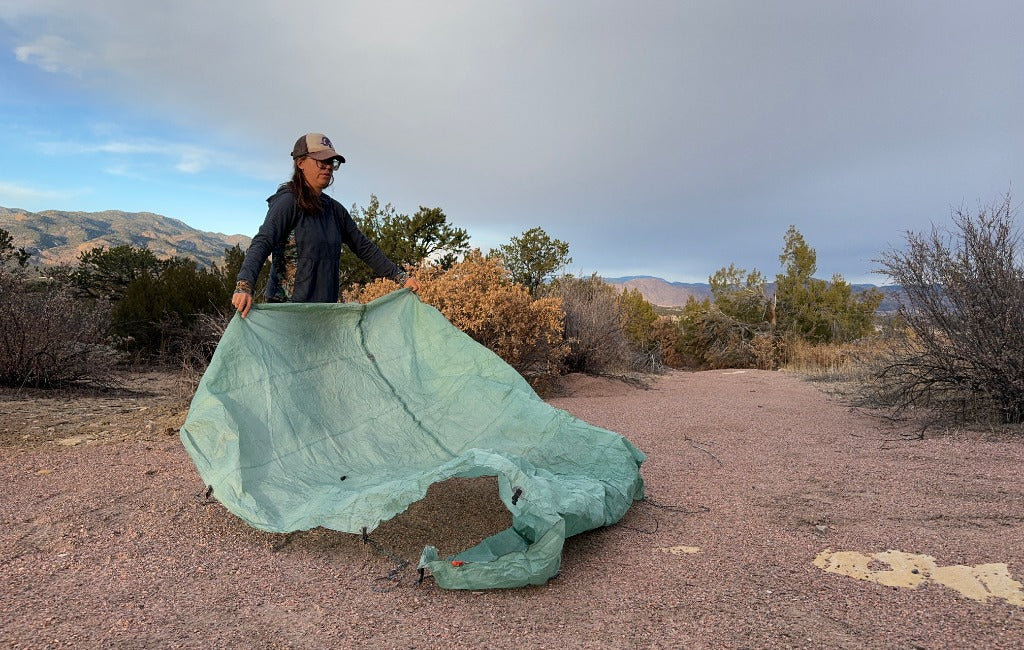
Material
The big draw of the Flat Tarp is it's extremely lightweight. In order to achieve this HMG uses a thin Dyneema Composite Fabric which consists of Dyneema fibers laid out in perpendicular grid patterns, then sandwiched between polyester films. This creates a fabric that is strong for its weight as well as waterproof. One thing I really appreciate about this fabric is that it holds its shape when wet.
It is also easier to get rid of excess water from the fabric by shaking it before packing it up. Besides being waterproof, DCF is purported to be UV resistant and hold its shape at stress points. Over five months of use I found that the Flat Tarp did appear to be a bit faded on the sky-facing side.
I also noticed that the corners seemed to be slightly stretched from bearing a large amount of stress particularly as I typically used the same two pitches over and over. Neither of these things seemed to hinder the tarp's performance but are something to bear in mind.
Other materials used include the plastic line lock tensioners and the UHMWPE core guy lines. Plastic parts are always a bit concerning as they can be a point of failure when under stress. That said, they seemed to hold up well to consistent use and in the worst-case scenario it is still more than possible to pitch the tarp without them if they were to fail in the backcountry.

I noticed that individual Dyneema fibers were pulling away from the fabric.
HMG also includes 6 approximately 4-foot guy lines and approximately 6-foot guy lines with loops already tied on the ends. The UHMWPE (ultra-high-molecular-weight polyethylene) lines are extremely light and water-resistant while remaining strong. They work well for pitching tarps in my experience, though picking up an uncut length from HMG or another brand might be helpful for those who want to customize guy line length or need a ridgeline cord.
Durability
One area where I was disappointed with the Flat Tarp’s performance was its durability and weather resistance. When it comes to durability specifically, this seems to be a manufacturing problem. Over the course of my thru-hike, I noticed that individual Dyneema fibers were pulling away from the fabric. I tried hard to care for the tarp by being careful when packing it as well as being cognizant of where I set it up.
However, by the end of the hike, there were many small micro holes in the fabric. Maybe this would be less of an issue in wetter climates as there are certainly many pokey plants in the deserts where I was using the tarp, but it seems to me that the fabric should have held up longer before showing so much wear.
Weather Resistance
As far as weather resistance, much of the Flat Tarps' weaknesses can be attributed to using this style of shelter in general. I found that when the weather was great, it was a wonderful weight-saving shelter to have. However, when the weather was terrible it seemed to be more stressful than the weight savings were worth.
There are many more factors that can make or break a good night's sleep when using a flat tarp in inclement weather compared to better-enclosed shelters, be it free or non-freestanding. As previously mentioned, campsite selection is an extremely important foundation for weather resistance. Slightly elevated ground helps prevent flooding, pine needles minimize condensation, and trees protect from the wind. Unfortunately, there is not always a good campsite available to choose from.
Choosing the correct pitch and which direction to face the tarp entrance also plays a big factor. I observed that the more stormproof the pitch, the less interior space was inside the tarp and it also felt less cozy than other tents I have used. That meant setting up a protected shape was not usually practical.

The pitch and entrance direction significantly influence the tarp's interior space and comfort.
Similarly, there were several nights when the weather was nice out when I went to bed, but it started to run unexpectedly in the middle of the night. Rather than just zipping a fly shut as one would do with other shelters, I had to either accept getting wet or get up and adjust the pitch in the rain. No fun either way.
As for other types of weather, the Flat Tarp did okay. It was usually solid in the wind, but that really was dependent upon which direction it was coming from and the pitch. I never had anything break, though flapping was common. It did collapse once or twice based on how the poles were placed, but that was an easy fix.
The most frustrating thing was having grit blowing around inside the tarp while in the open desert. Not a huge issue if there is cover, but it's a worthy consideration for those camping in wide open areas. I did not have the opportunity to test this shelter in hail.
For the most part, the issues the HMG Flat Tarp faces are common to all such open and simple shelters. Careful consideration of its strengths and weaknesses, good site selection, and an array of pitch formations can help minimize a good chunk of the negatives. Sadly, that doesn’t make up for some of the durability issues so care will be needed when using this specific tarp to extend its longevity.




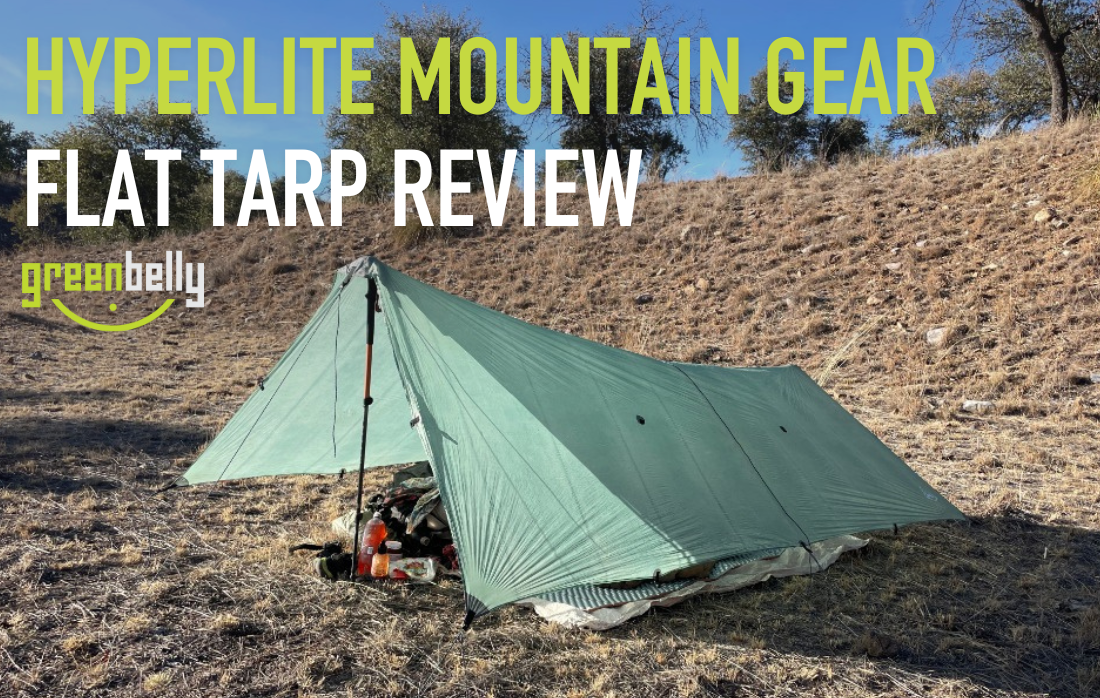


 650-Calorie Fuel
650-Calorie Fuel